8 Lead Magnet Ideas For Your Digital Agency [with Examples]
Published: September 15, 2016Updated: December 20, 2024

You may recommend lead magnets to your clients, but are you using one yourself? Here’s how your digital agency can develop lead magnets that generate sales, plus 8 formats and ideas to get you started.
Ryan Deiss, CEO and founder of Digital Marketer, describes a lead magnet as “an irresistible bribe offering a specific chunk of value to a prospect in exchange for their contact information.”
If you run a design, development, or marketing agency you may have recommended a lead magnet to your clients to drive leads into a sales funnel. But very often I come across agency websites whose only call-to-action is “contact us”. Kind of lame, but more importantly, a huge missed opportunity.
Especially since when I talk to digital agency owners they tell me that lead generation is one of their biggest problems, with most relying simply on word-of-mouth and referrals from past clients.
Why should you create a lead magnet?
At the mall food-court near my place there’s a Mediterranean spot called Villa Madina.
Any time I’m walking around trying to decide what to get for lunch, I’m met with a warm smile from the guys running the food stand.
As soon as our eyes meet, one of them holds out a free sample on a skewer, beckoning me to come closer. How can I turn down free chicken souvlaki? Once I taste it I know that’s what I’m having for lunch, and I almost always end up ordering a full meal.

Think of your lead magnet as that free skewer that sucks your prospect in and makes them hungry to buy.
For an agency business, a lead magnet should answer a question for your target customer in a way that naturally leads them to hiring your agency.
People who hire agencies typically work in-house at companies and are tasked with managing projects they have little skill or experience in, such as managing an ad spend, or planning a mobile app.
Before they even think of hiring an agency, many are searching the web looking for resources to help them answer specific questions.
This presents you with a golden opportunity to be the solution to their problems. If you can provide value on a small scale and showcase your agency’s expertise, the natural next step (if you position yourself correctly) is for the lead to contact you for a proposal.
What should your lead magnet be about?
What are your ideal clients looking for help with? What burning problem are they trying to solve?
The easy way to answer this is to think about conversations you have every day. When someone you meet learns what you/your company does, what question do they usually ask you?
Remember, the more specific your services, the better. What do you do better than your competitors? This could be working in an industry segment (vertical) or with a unique skill or software platform (horizontal).
For example, if you’re an app development shop, it’s better to go ultra-specific based on your expertise. Like, how to design hotel bookings on mobile devices rather than to be broad and general, like how to build an app.
OK, so now you know what question you need to answer for your prospect. What format should you choose?
Lead magnet formats
I’m going to brainstorm some lead magnet ideas that are specific to mobile app designers who specialize in working with SaaS startups, and digital agencies who specialize in working with hotels and travel companies.
I’m using these lead magnet examples to get your creative juices flowing. You can then take any of the ideas and put your own unique spin on it, making sure to connect your particular value proposition and your customer personas.
1. Webinars
Webinars are one of the best tools digital agencies can use to establish their authority on a subject, educate their listeners, and field multiple warm prospects simultaneously.
Our imaginary mobile app design company that works with SaaS startups could host a webinar called, “The 3 Questions SaaS Companies Need to Answer Before Planning a Mobile App”.
A title like this ensures that:
1) the people signing up are actually in the early stages of planning their mobile app
2) they are a SaaS company
3) they want to make sure it’s done right.
This naturally filters out prospects who likely aren’t a good client fit, and it enables you to speak directly to the prospects who are at the right stage of the buying cycle.
How to get started
Hosting a webinar is as simple as using YouTube. Google recently retired Hangouts On Air in favour of using YouTube directly.
Go to your YouTube account and click on My Channel > Video Manager
Then click on Live Streaming.
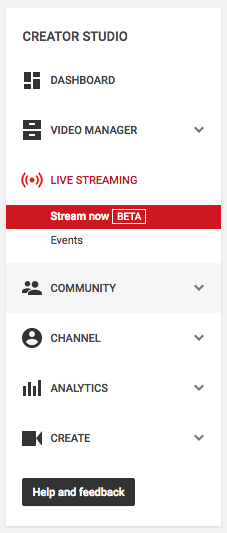
You’ll see that you can add a title and description, start encoding, and you’re live.
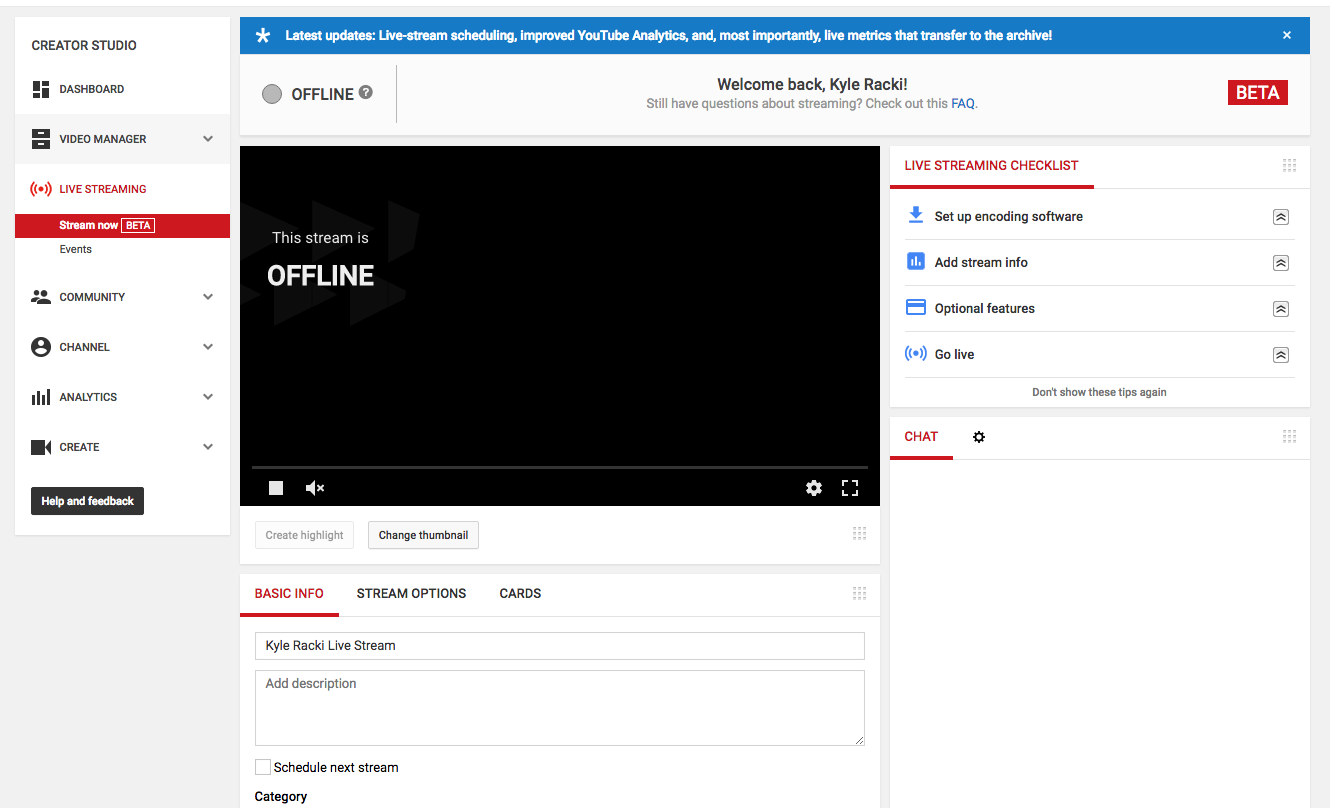
From the tech side, it’s about as simple as that! Of course you’ll also need a landing page and funnel to start inviting prospects to your webinar, which we’ll cover more later. Learn more tips on hosting effective webinars.
2. Consultation
A consultation is probably the easiest, most obvious lead magnet you can offer.
A word of caution, though — many people coming to your website will be hesitant to book a free consultation because they expect you’re going to be trying to sell them on your services.
On the other hand, you may get overwhelmed by the volume, offering free consultation to low quality leads that don’t go anywhere.
To avoid either of these problems, introduce scarcity when offering consulting as a lead magnet. Free consults work better as lead magnets when you make them appear like prizes you’re only awarding to a select number of people.
To do this, you need to establish authority first through books, webinars, or public speaking, so I’d only recommend offering a free consultation if you already have a reasonably strong personal brand and a channel that presents you as an authority on a subject.
It may work better to only offer a small number of free 30-minute calls at the end of a webinar, or to have a web form to book the call that filters out bad leads.
3. Audit/analysis
Audits, or analyses, are the more tangible version of a consultation. It’s where you perform research on your lead’s business or website and produce a customized report outlining what they are doing well, and what they can improve. The obvious next step being that they hire your agency to fix or improve what they’re doing wrong.
In most cases, you’ll want to save time by using software tools to pull together information. For example, using Hubspot’s free website grader you can perform a basic site analysis that uncovers how well your lead’s website performs when it comes to SEO, mobile, speed, security, and other factors.
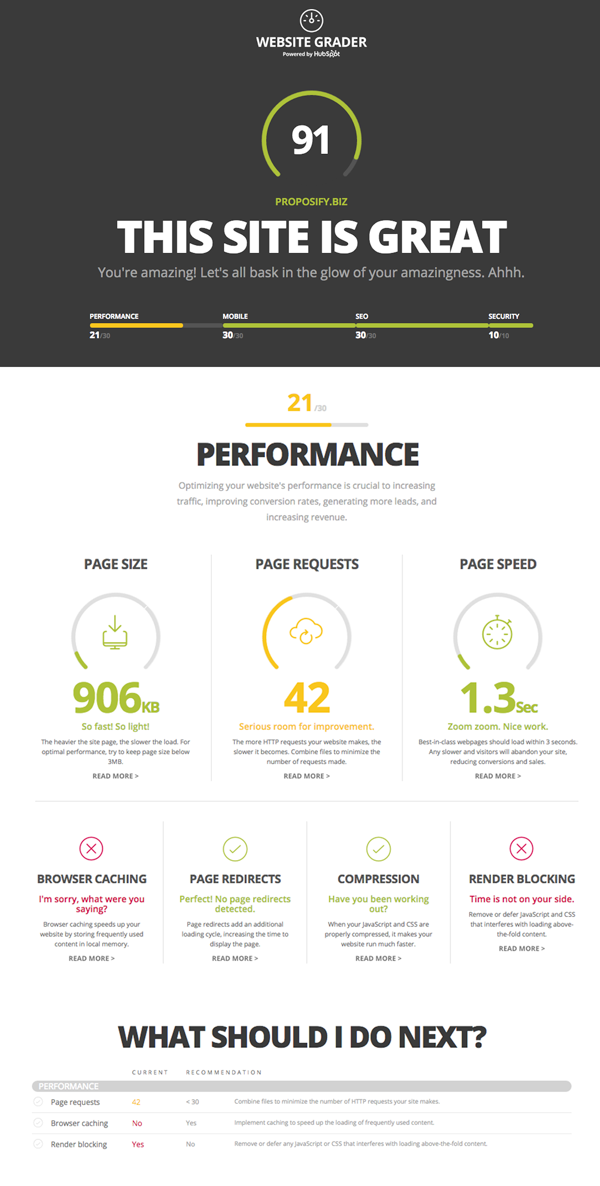
If you’re an SEO agency you could use a tool like Positionly to uncover search data about your lead or their competitors.
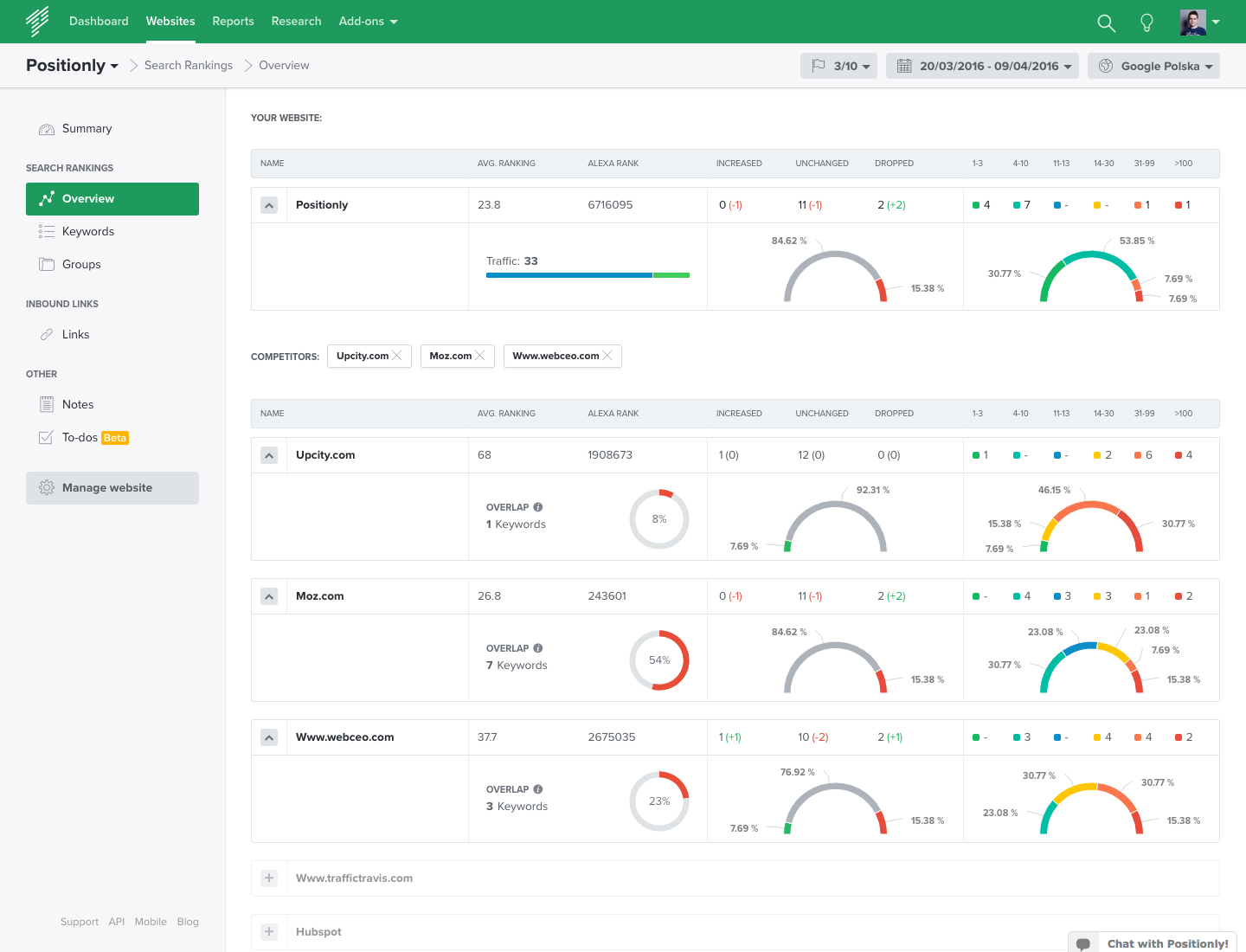
If you’re a social media agency, you could use BuzzSumo to find your lead’s most shared content and offer some tips to create content that will outperform their competitors.
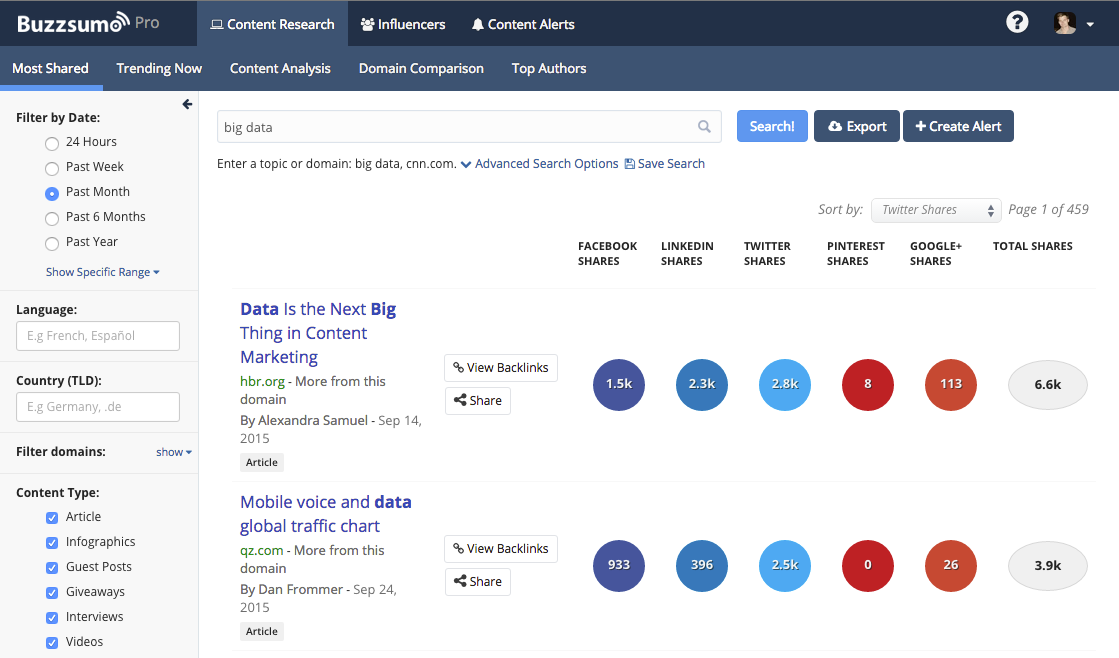
Once you have the data you should pull it into a nicely designed PDF report that’s branded to your agency.
Analyses are similar to consultations in that you want to be very selective about who you offer them to so your salespeople aren’t wasting hours performing them for unqualified leads.
The keys points to using analyses as a lead magnet are:
- Make them fast and easy to pull together
- Make them helpful and actionable, but don’t give away the farm
- Make contacting the agency for a proposal the natural next-step
How to get started
Think about what kind of audit or analysis you perform when onboarding a new client for the first time. How can you take a sample of what you do and give away just enough of a taste to intrigue your prospect to want to hire your agency?
Have your designer create a beautifully branded document template to format the reports and be sure to make it as easy as possible to reproduce them.
4. Email course
When someone comes across your website they usually aren’t quite ready to contact you for a project.
Offering a free 5-day email course can be a great way to get their email address and warm them up until they’re ready to take the next step, like a call for a proposal.
While we aren’t an agency, here at Proposify we’ve been using a 5-day email course as a lead magnet for more than a year, and it still drives leads into our funnel that convert.
As you can see, the open rates are quite high (30-60%) and the unsubscribe rate low (0.56%).
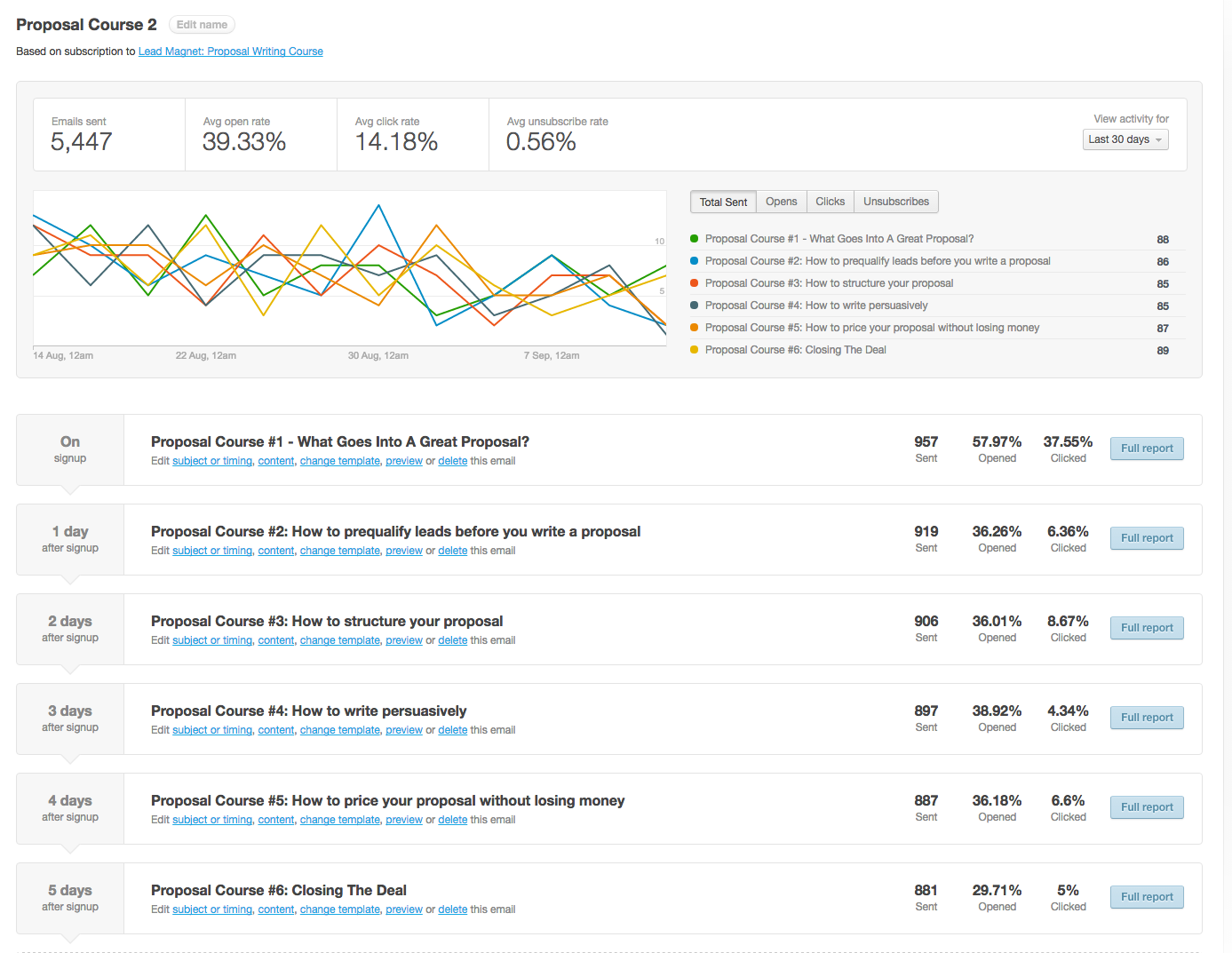
If you’re a marketing agency that works with travel and hotel brands, your 5-day email course could be something like “Free Email Course: 5 Steps to Increasing Online Bookings by 106%”
The headline speaks to the client’s pain — increasing bookings — and allows them to learn at their own pace before contacting your agency to learn more.
Every day they’ll get an email with some valuable advice and actionable takeaways.
By day 4, you can begin showing how your agency used these same tips to increase bookings for a client by 106% (or whatever the increase was), and naturally lead them to want to contact you for a proposal.
How to get started
Once you have your content written, it’s as simple as using a tool like Campaign Monitor (which is what we use), Mailchimp, or something more specific like Drip, to build and automate your email course.
Read this article for more information on creating email courses.
5. Report
A report is a data-driven piece of content — usually a PDF or slide deck — that offers the reader in-depth and up-to-date information about a given topic.
Your prospective clients may be searching for reports that show worldwide trends related to their current project so they can be better informed going into it, or they may need to pitch the need for a project or campaign to their bosses.
At Proposify, we created a free report by poring through aggregate data around proposal creation within our product and put it together in an attractive PDF called The Data Driven Guide to the Perfect Proposal. It’s full of sexy stats around proposal creation like the average time between creating and sending a proposal, how long it takes for clients to view and accept, and how online signatures improve close rates.
Here’s one of the pages in our guide that visually illustrates why it’s important to send proposals as quickly as possible so that leads don’t go cold:
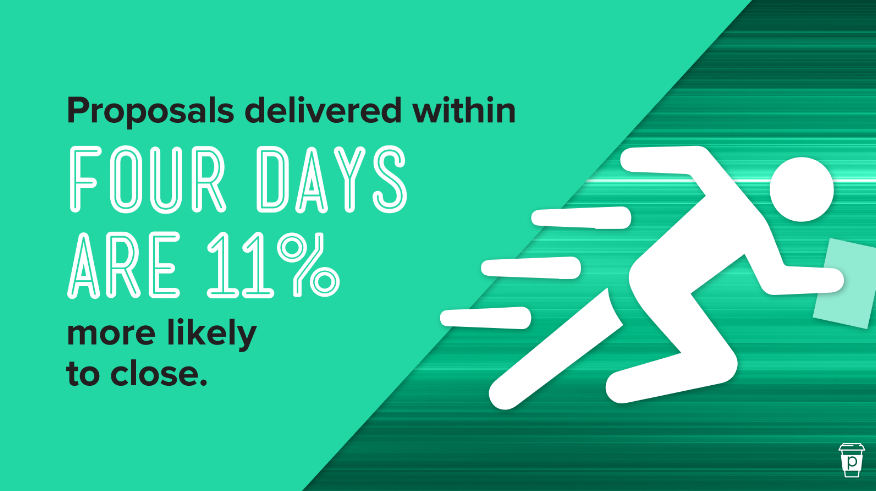
The landing page for this report converts at over 31% and about 4% of people who download it try out our product. Not bad for evergreen content that just sits and collects leads.
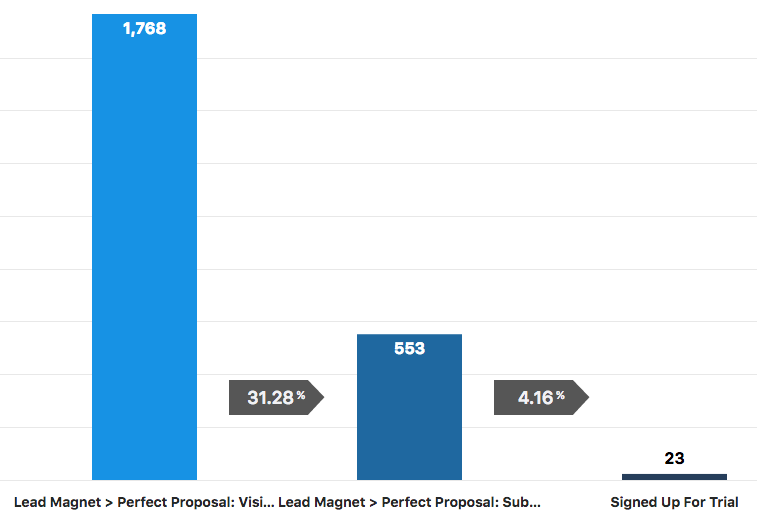
If you’re the mobile app agency that works with SaaS startups, your report could be “3 Mobile Statistics Every B2B SaaS Company Needs To Know In 2016”.
In it, you pull together stats from the previous year that indicate where mobile is going, and how to apply it to the future of SaaS.
How to get started
Start by collecting useful data about your topic. You can find expert research on Google Scholar and statistics on Statista. See other places to find statistics.
Next, have your designer create a beautiful, well-designed report using the data. The report should be super-visual and very light on text. The goal is for your lead to print off a page or two of the guide and stick it to the wall in their company’s lounge.
6. Guide/cheat sheet
The difference between a report and a cheat sheet is that a report teaches you the what, and the guide/cheat sheet teaches you how, in step-by-step instructions.
This is paint-by-numbers and should be extremely short and actionable. Like the report, it’s something beautiful you want your lead to print and stick on their wall.
Here’s a lead magnet example of a Scrum cheat sheet.
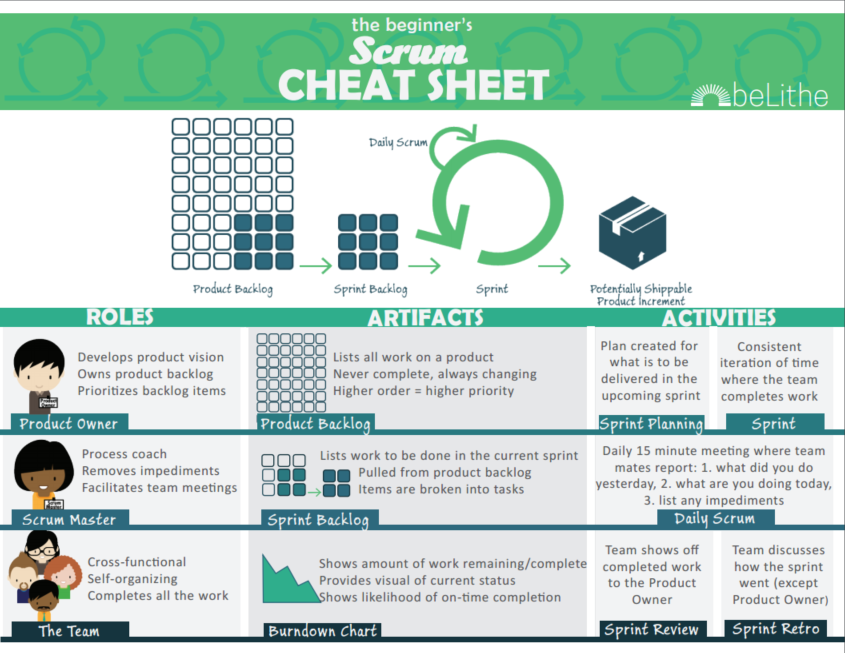
In our example of the mobile app shop, you could create a guide outlining a list of common design patterns for mobile, and how they differ from desktop software. Call it, “How to Build a Seamless Mobile Experience for your SaaS Customers”.
How to get started
Think about what your prospective client may be searching for as they plan a project. This could appeal to the DIY types who think they can hack something together on their own, only to later realize they need an agency (yours!).
Use your in-house copy and design firepower to create an engaging one-page cheat sheet or infographic they can use as a quick reference guide. Don’t forget to include your branding and call to action!
7. Tool Kit
Have you ever had someone in your agency painstakingly create something for the rest of your team to use in-house? Think templates, or UI widgets, or content management client guides?
Instead of keeping it to yourself, open source that shit!
When I ran an agency we did this with our ExpressionEngine Client Guide, letting visitors download the customizable working files of the same guide we gave to clients. It was a huge hit at the time.
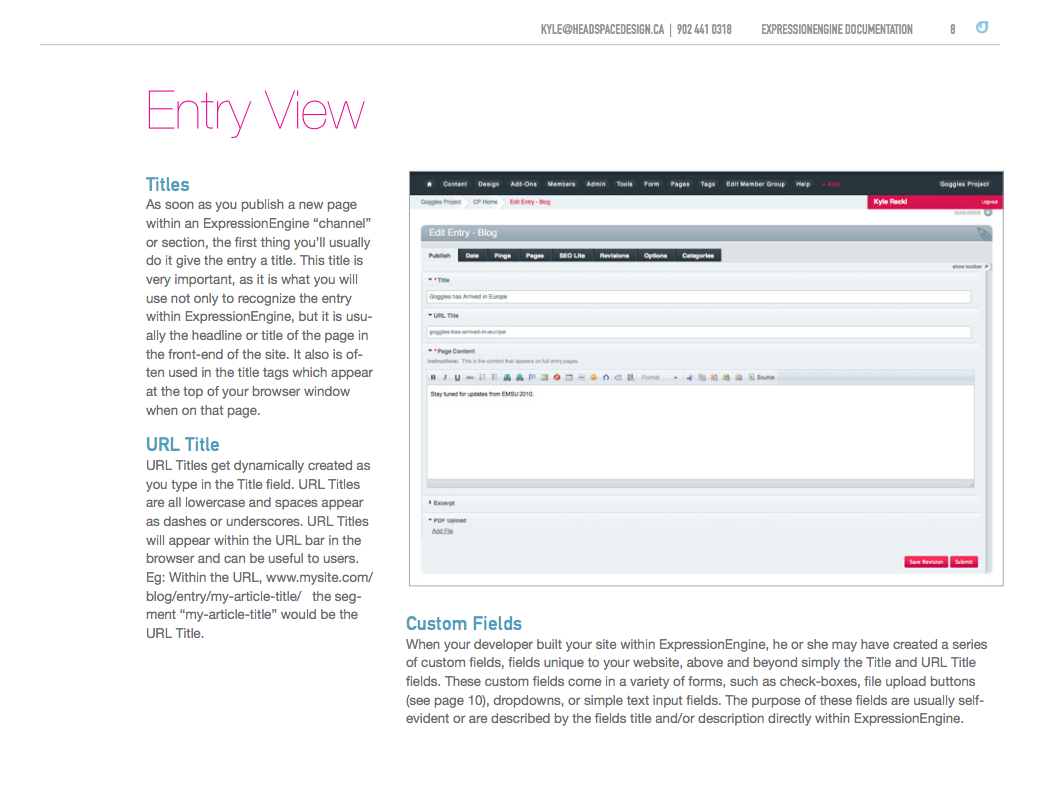
Long before they were bought by Facebook, Teehan Lax released their iPhone GUI Kit as both Photoshop and Sketch files.
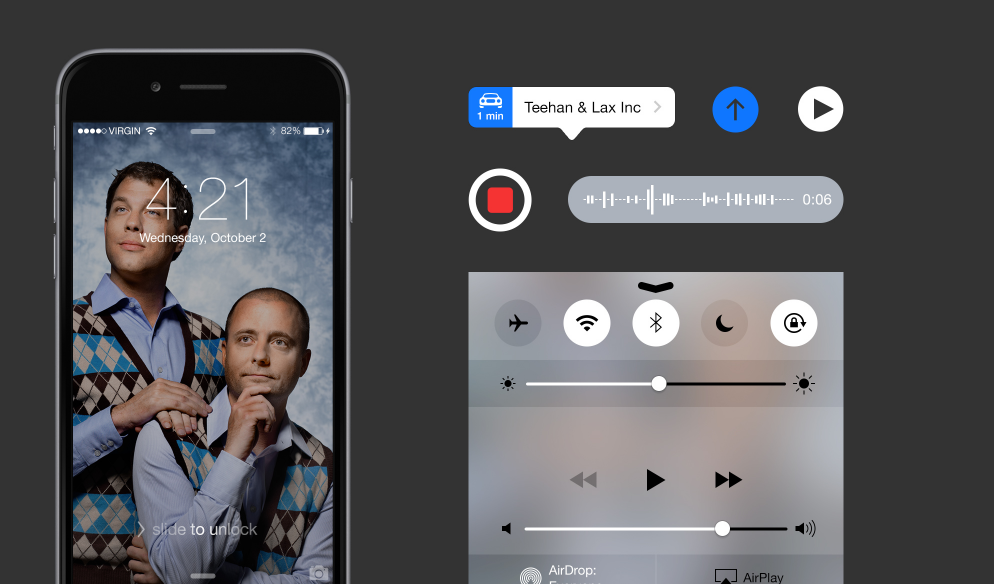
While neither of these are being used as direct lead magnets (you don’t need to leave your contact details to download the tools), you could easily require a sign-up in order to download.
If you’re a digital marketing agency, you could release a free 90-day social media calendar tailored specifically for hotel/travel companies, or whatever your industry niche is. Be sure to include your agency branding and website, along with a CTA somewhere so they know to contact you for a proposal.
How to get started
Think about what assets you’ve created internally that your prospective clients could benefit from, but isn’t your core product.
Are there design files or software you’ve built for yourself clients that you can open up and make available free to leads?
8. Case study
At Proposify, we regularly pull together case studies and post them to our website, and users who visit the case studies convert over 14% higher than those who don’t!
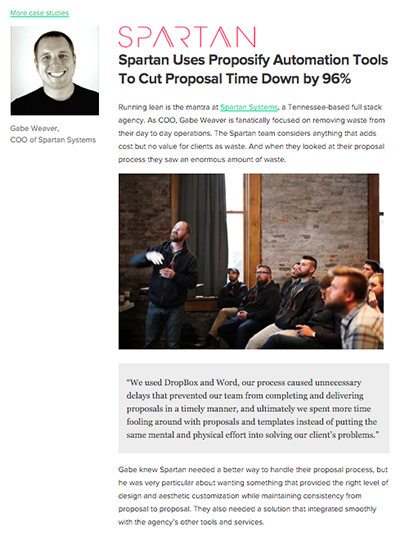
You don’t need to publicly present your case studies on your website. Instead, you can request an email address before sending them out and then use a tool to present the case study and track email opens.
a user who requests a case study is likely very warm to your company already and wants more in-depth, meaty example of how you’ve helped past clients.
We’ve already produced an in-depth post on creating great case studies, so check out the tips outlined there.
Turn your case study into a flipbook for a more engaging and interactive reading experience.
Driving traffic to your lead magnet
Once you’ve decided on your lead magnet and have begun the process of creating it, the next step is to think through the funnel. How will you get it into a prospect’s hands?
PPC
Facebook ads work great for this because 1.7 billion people are on FB, and you can directly target based on preferences, such as what blogs they read, what pages they like, and a ton more.
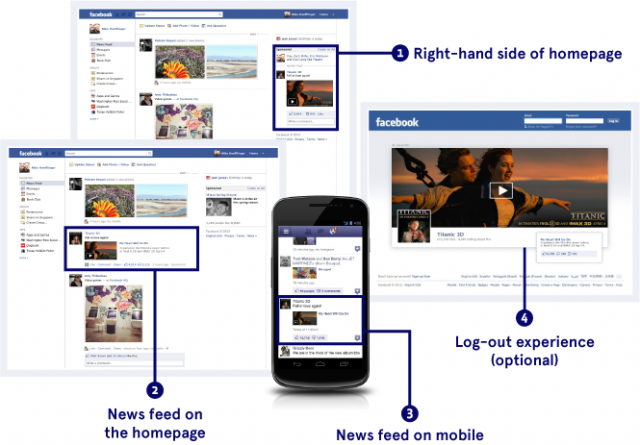
Don’t forget other social platforms as well, like Adwords, LinkedIn, Pinterest, Instagram, and Twitter.
Q&A sites
Quora and Reddit are also great for promoting lead magnets because people post questions the community can answer.
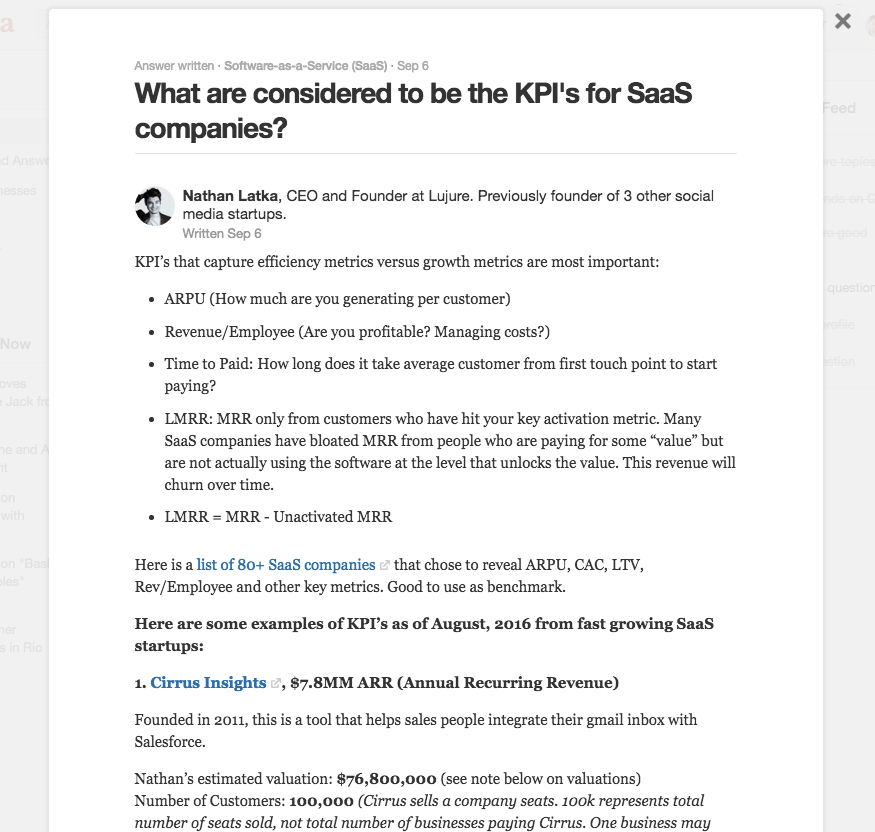
Answer the question in as much detail as you can, but post a link to your landing page for people to learn more. The better your answer, the more votes you’ll get to push the answer higher on the page.
Leverage other people’s networks
Guest blogging and speaking at conferences are effective ways to demonstrate your authority to your target audience.
At the end of a guest post, instead of linking directly to your site, link to the lead magnet landing page instead of your home page.
If you’re speaking at an event, post a phone number up on your closing slides at the end of your talk and ask the audience to text to receive your free offer. Once they text, set it to trigger an auto responder asking for their email to send them the lead magnet.
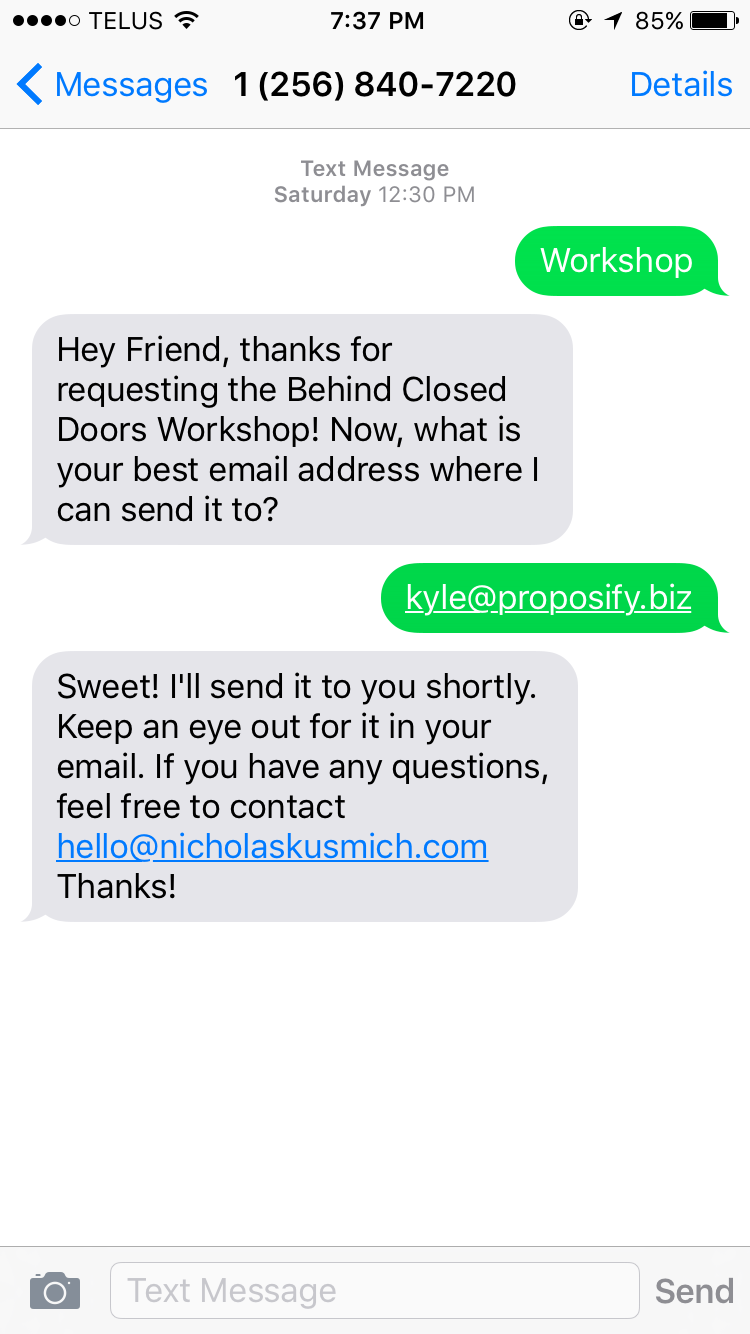
Pro Tip: Make the link expire after a set amount of time so people don’t procrastinate in consuming the lead magnet.
Bottom line: Test which channels send you the most qualified leads and then optimize your landing page for conversion. Especially for an agency business, quality of leads are much more important than quantity.
Be sure you have a tight follow-up process so that quality leads coming into your funnel are being nurtured and you’re sending proposals to the very best ones.
Conclusion
Agencies are notorious for the “cobbler’s kids have no shoes” mentality when it comes to their own sales and marketing. Few take the time to create a repeatable system for generating leads. I hope these lead magnet ideas inspire you to create your own. Let me know if there are any other ideas you have in the comments.

Co-founder and CEO of Proposify, and co-host of the Levership podcast. Outside of Proposify, he plays in the band Club Sunday, who put out their first LP in 2023 and enjoy playing live shows every chance they get. Follow him on LinkedIn.

